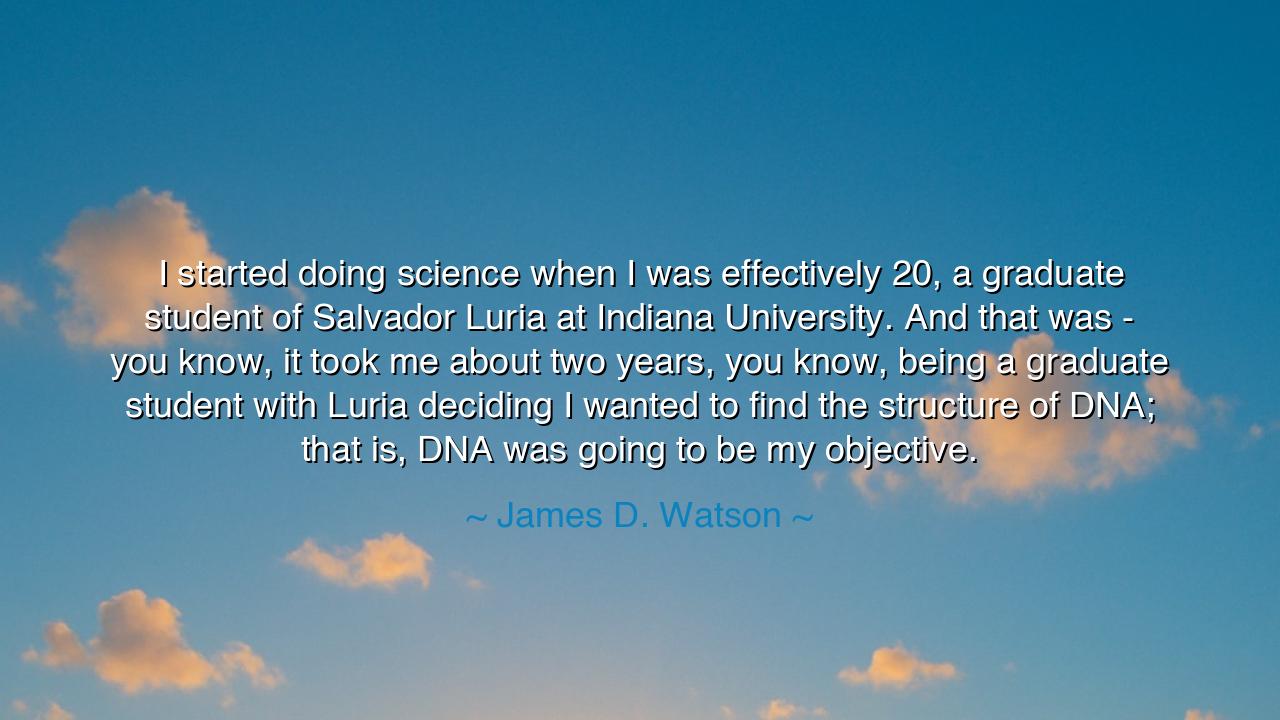
I started doing science when I was effectively 20, a graduate
I started doing science when I was effectively 20, a graduate student of Salvador Luria at Indiana University. And that was - you know, it took me about two years, you know, being a graduate student with Luria deciding I wanted to find the structure of DNA; that is, DNA was going to be my objective.






"I started doing science when I was effectively 20, a graduate student of Salvador Luria at Indiana University. And that was - you know, it took me about two years, you know, being a graduate student with Luria deciding I wanted to find the structure of DNA; that is, DNA was going to be my objective." These words from James D. Watson speak not only to the moment he found his calling but also to the very spirit of discovery that defines the pursuit of science. Watson, in his early years as a graduate student, found himself drawn to one of the most profound questions of the biological sciences: the structure of DNA. His resolve to make this his objective, to seek the truth hidden within the molecule that carries the very essence of life, reflects the determination and vision required to make great strides in the scientific world. It was not simply a choice to engage with science, but to dedicate oneself to unraveling one of the most complex and elusive mysteries of nature.
In the ancient world, the pursuit of knowledge was often seen as the highest of callings. Plato and Aristotle, in their philosophical inquiries, sought to understand the very structure of the world around them. Plato, in his dialogues, wrote about the ideal forms, the unseen truths that govern all existence. His student, Aristotle, moved beyond theory to examine the natural world through empirical observation, laying the foundation for the scientific method. For the ancients, knowledge was never merely academic—it was a passion, a purpose that shaped lives and destinies. Watson’s commitment to understanding the structure of DNA is in this ancient tradition: it is a devotion to uncovering the very fabric of life itself, a quest that transcends mere curiosity and becomes a lifelong mission.
Think of the great minds who, through their tireless work and vision, shaped the course of human understanding. Isaac Newton, in his youth, set out with a singular mission to understand the forces that governed the natural world, and through his insight and dedication, he developed the laws of motion and gravity that still define physics to this day. Much like Watson, Newton did not just study science—he made it his life’s work, dedicating his intellect and spirit to a single, profound objective. Newton’s achievement was not the product of chance, but of deep commitment and purpose, qualities that Watson echoed in his own journey to uncover the mysteries of DNA.
The story of Watson’s pursuit of the structure of DNA is not merely one of intellectual curiosity but one of relentless ambition and a desire to make a lasting impact on the world. His work, along with that of Francis Crick and Rosalind Franklin, ultimately led to the discovery of the double helix structure of DNA, a breakthrough that revolutionized biology and opened the door to fields like genetics, medicine, and biotechnology. In deciding to make this his objective, Watson demonstrated that science is not simply about learning what has been discovered but about taking the next step in human understanding—to build upon the work of those who came before and create new pathways for future generations to follow. His journey was driven by a vision of what science could accomplish and by a willingness to dedicate himself to that vision, regardless of the challenges.
However, it is not just the final discovery of the structure of DNA that makes Watson's story so powerful. The journey itself—the years spent immersed in the pursuit of knowledge, the sacrifices made, and the moments of doubt and uncertainty—is equally significant. Much like the ancient philosophers and scientists, Watson encountered the struggle inherent in every great discovery: the feeling that one may be pursuing something unattainable, the fear that one’s efforts may be in vain. But it was in those early years, as a graduate student under the guidance of Salvador Luria, that Watson forged his commitment, choosing to make DNA his life’s work. It was not a casual decision, but a dedication to something greater than himself, to the pursuit of knowledge and the transformation of that knowledge into meaningful discovery.
The lesson here is powerful: science is not simply about knowledge, but about vision and commitment. It requires a single-minded purpose, as Watson demonstrated in his dedication to understanding DNA, but it also requires patience and perseverance. The road to discovery is rarely straight or easy; it is filled with moments of uncertainty and difficulty. But those who succeed, like Watson, are those who choose to make their objective their life's pursuit, dedicating themselves fully to the process of discovery. Like the ancients, we must recognize that knowledge is not something to be obtained quickly or easily, but something that requires devotion, focus, and an unwavering commitment to a greater purpose.
In your own life, remember that the pursuit of any great goal—whether in science, art, business, or personal growth—demands more than just talent or intellect. It requires an unshakable commitment to a vision, the persistence to overcome challenges, and the clarity to focus on one objective at a time. Like Watson, choose something that inspires you deeply, something that will drive you to wake up each day with purpose and passion. It is through this dedication and focus that we move the world forward, step by step, discovery by discovery.






AAdministratorAdministrator
Welcome, honored guests. Please leave a comment, we will respond soon